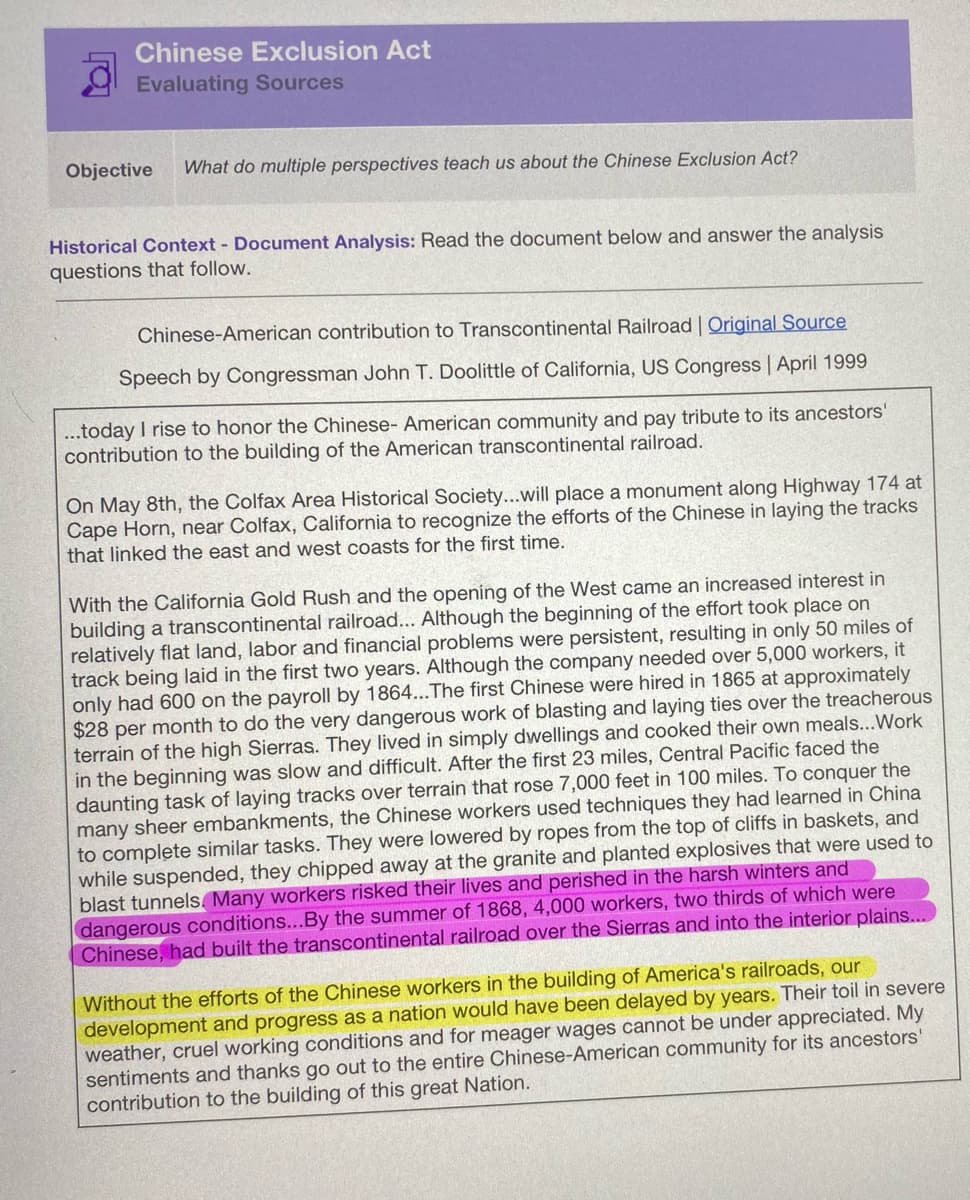4) Analysis: Based on this document, how important do you think Chinese labor was to the American economy in the late 1800's? Cite evidence from the text to support your claims.
4) Analysis: Based on this document, how important do you think Chinese labor was to the American economy in the late 1800's? Cite evidence from the text to support your claims.
Related questions
Question

Transcribed Image Text:4) Analysis: Based on this document, how important do you think Chinese labor was to the
American economy in the late 1800's? Cite evidence from the text to support your
claims.

Transcribed Image Text:Chinese Exclusion Act
Evaluating Sources
Objective
What do multiple perspectives teach us about the Chinese Exclusion Act?
Historical Context - Document Analysis: Read the document below and answer the analysis
questions that follow.
Chinese-American contribution to Transcontinental Railroad | Original Source
Speech by Congressman John T. Doolittle of California, US Congress | April 1999
...today I rise to honor the Chinese- American community and pay tribute to its ancestors'
contribution to the building of the American transcontinental railroad.
On May 8th, the Colfax Area Historical Society...will place a monument along Highway 174 at
Cape Horn, near Colfax, California to recognize the efforts of the Chinese in laying the tracks
that linked the east and west coasts for the first time.
With the California Gold Rush and the opening of the West came an increased interest in
building a transcontinental railroad... Although the beginning of the effort took place on
relatively flat land, labor and financial problems were persistent, resulting in only 50 miles of
track being laid in the first two years. Although the company needed over 5,000 workers, it
only had 600 on the payroll by 1864...The first Chinese were hired in 1865 at approximately
$28 per month to do the very dangerous work of blasting and laying ties over the treacherous
terrain of the high Sierras. They lived in simply dwellings and cooked their own meals...Work
in the beginning was slow and difficult. After the first 23 miles, Central Pacific faced the
daunting task of laying tracks over terrain that rose 7,000 feet in 100 miles. To conquer the
many sheer embankments, the Chinese workers used techniques they had learned in China
to complete similar tasks. They were lowered by ropes from the top of cliffs in baskets, and
while suspended, they chipped away at the granite and planted explosives that were used to
blast tunnels. Many workers risked their lives and perished in the harsh winters and
dangerous conditions...By the summer of 1868, 4,000 workers, two thirds of which were
Chinese, had built the transcontinental railroad over the Sierras and into the interior plains..
Without the efforts of the Chinese workers in the building of America's railroads, our
development and progress as a nation would have been delayed by years. Their toil in severe
weather, cruel working conditions and for meager wages cannot be under appreciated. My
sentiments and thanks go out to the entire Chinese-American community for its ancestors'
contribution to the building of this great Nation.
Expert Solution
This question has been solved!
Explore an expertly crafted, step-by-step solution for a thorough understanding of key concepts.
This is a popular solution!
Trending now
This is a popular solution!
Step by step
Solved in 3 steps

Follow-up Questions
Read through expert solutions to related follow-up questions below.
Follow-up Question
According to the first paragraph what is the purpose of his sp
Solution